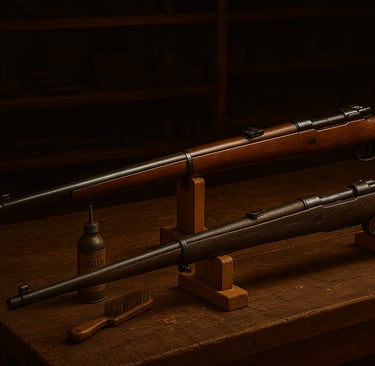Historic Military Surplus Firearms:
Restoration vs. Preservation
10/1/20252 min read


There’s something special about holding a piece of military history in your hands — the worn bluing, the faint stock cartouches, and the smell of old cosmoline. Military surplus firearms are more than just guns; they’re artifacts that tell stories of battles, soldiers, and eras gone by.
But when that rifle or pistol lands on your workbench, the question every collector faces is:
Should I restore it… or preserve it “as is”?
Let’s look at how to make the right call.
The Case for Preservation
Preservation means stabilizing a firearm’s condition without changing its original finish, markings, or parts. For many collectors, authenticity is everything.
Why Preserve
Historical Value: Original finishes, dings, and wear patterns authenticate its story. Once altered, that history is lost.
Collector Demand: Unmodified rifles often bring higher resale and trade value.
Museum-Grade Mindset: The goal is to protect, not alter — cleaning and oiling to prevent further decay without disturbing the patina.
What Preservation Looks Like
Gentle cleaning only — removing dirt, not finish.
Applying light oil to protect from rust.
Leaving arsenal marks, battle wear, and matching serial numbers untouched.
A preserved rifle is a time capsule, not a showpiece — and that’s what makes it special.
The Case for Restoration
Restoration goes a step further. It involves returning a firearm to functional or aesthetic condition — refinishing metal, repairing stocks, and replacing worn parts.
Why Restore
Functionality: You want it to shoot safely and reliably again.
Pride of Ownership: Restoring can be deeply rewarding, especially when breathing life back into a neglected piece.
Educational Value: A restored rifle demonstrates original craftsmanship and design for display or teaching.
What Restoration Involves
Stripping old finishes and applying new bluing, parkerizing, or Cerakote.
Repairing or replacing cracked wood stocks.
Replacing worn springs, bolts, or small parts to ensure safety.
The Trade-Off
Every time you refinish or replace, you reduce originality. A 1943 M1 Garand with its factory finish may be worth more than a beautifully restored one. Restoration adds aesthetic appeal but subtracts historical purity.
Finding the Middle Ground
The best approach often lies somewhere in between — what gunsmiths call sympathetic restoration. The goal is to make the firearm safe and stable while respecting its age and character.
For example:
Clean and conserve the metal, but avoid full refinishing.
Stabilize cracks in the stock without sanding away cartouches.
Replace only non-serial-numbered parts to restore function safely.
This balance preserves the story while ensuring longevity — a philosophy embraced by both museums and discerning collectors.
When to Consult a Gunsmith
Before attempting any restoration, have the firearm professionally inspected. Many surplus guns are decades old, and safety should always come first.
A gunsmith can:
Evaluate structural integrity and chamber condition.
Check headspace and firing pin protrusion.
Recommend safe cleaning, lubrication, and rust removal techniques.
Attempting to refinish or fire an old rifle without inspection can risk both safety and value.
Final Thoughts
Every historic firearm tells a story — from the trenches of Europe to the jungles of the Pacific. Whether you restore or preserve depends on your purpose:
Collector? Preserve it.
Shooter? Restore it.
Historian at heart? Do a careful mix of both.
There’s no wrong answer — only respect for the craftsmanship and the history in your hands.
👉 Thinking about restoring or preserving your military surplus firearm? Bring it to JT Arms for a professional evaluation. We’ll help you decide how to protect — or resurrect — your piece of history.
